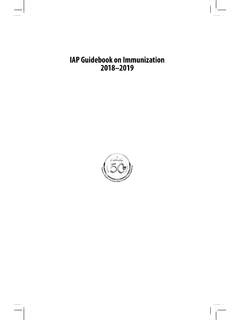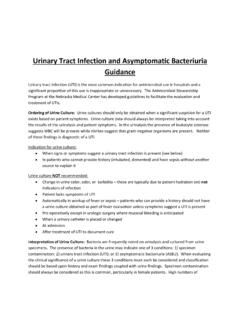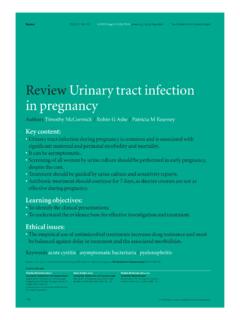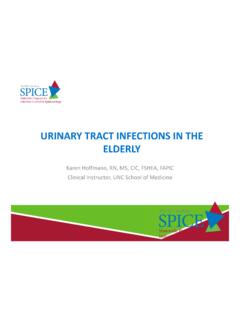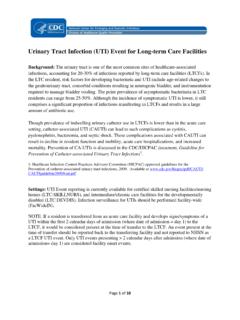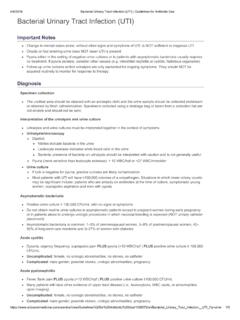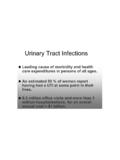Transcription of Indian Academy of Pediatrics (IAP) STANDARD TREATMENT
1 Urinary Tract Infection in ChildrenLead Author Sudha EkambaramCo-Authors Afsana Jahan, Kiran P SatheIndian Academy of Pediatrics (IAP) STANDARD TREATMENT GUIDELINES 2022 Remesh Kumar RIAP President 2022 Upendra KinjawadekarIAP President-Elect 2022 Piyush Gupta IAP President 2021 Vineet Saxena IAP HSG 2022 2023 Under the Auspices of the IAP Action Plan 2022 Indian Academy of PediatricsIAP STANDARD TREATMENT Guidelines CommitteeChairpersonRemesh Kumar RIAP CoordinatorVineet SaxenaNational CoordinatorsSS Kamath, Vinod H RatageriMember SecretariesKrishna Mohan R, Vishnu Mohan PTMembersSantanu Deb, Surender Singh Bisht, Prashant Kariya, Narmada Ashok, Pawan KalyanUrinary Tract Infection in Children1 Urinary tract infection (UTI) is a common bacterial infection in young children.
2 Delay in diagnosis and TREATMENT can lead to irreversible and long-term damage to the developing kidneys. It may result in renal scarring, hypertension, and renal insufficiency. Diagnosis of UTI in young children is made in presence of: ;Symptoms such as fever, dysuria, urgency, frequency, abdominal/flank pain in older children and fever, vomiting, diarrhea, and poor weight gain in infants PLUS ;Positive dipstick for leukocyte esterase and nitrite (as a screening tool) ;Abnormal urinalysis with significant pyuria and bacteriuria AND ;Isolation of single species of microorganism in significant number in a properly collected urine sample prior to starting antimicrobial therapy and tested for urine culture (gold STANDARD ) asymptomatic bacteriuria is considered in presence of: ;Significant bacteriuria in absence of pyuria or symptoms ;More common in girls compared to boys.
3 Often associated with nonvirulent Escherichia coli colonization ;Ideally should not be treated with unnecessary antimicrobialsSignificant bacteriuria : It is based on the colony count in the urine culture and method of collection (Table 1). Table 1: Colony count in the urine culture and methods of of collectionColony count (per mL)Suprapubic aspirationAny numberUrethral catheterization>104 Midstream void>1056 IntroductionBacteriuriaUrinary Tract Infection in Children4 Sample CollectionIdeal sample of urine for urine culture for diagnosis of UTI in young children: ;Toilet-trained children: Midstream collected urine by clean catch method (most preferred, noninvasive practical method). Genital area should be cleaned properly with soap and water before collecting midstream urine sample.
4 ;Non-toilet-trained children: Simple urethral catheterization OR Suprapubic aspiration Note: Urine sample should never be collected from urobag or minicom in neonates, infants, and older children. Urine sample should be processed as soon as possible ideally within 30 minutes of collecting the sample to avoid contamination and incorrect result. Risk factors for UTI in young children (look for presence of any of these in your patient): ;Poor perineal hygiene and unnecessary use of diapers ;Congenital anomalies of kidney and urinary tract (CAKUT) such as vesicoureteric reflux, pelvic ureteric junction obstruction, obstructive uropathy, abnormal communication between urinary tract and gastrointestinal tract, phimosis in boys, vulval synechiae in girls, and renal stones ;Bowel bladder dysfunction (BBD) presenting with features of urinary urgency, frequency, dysuria, voiding postponement during the toilet training age group, incontinence, and constipation.
5 Almost 50% children with recurrent UTI and 10% children presenting with a single UTI have an associated urological abnormality ;Fungal UTI is more common in immunocompromised patients, intensive care unit (ICU) setting, prolonged antibiotic usage, and in presence of indwelling catheters Risk FactorsCommon organisms causing UTI are: ;E. coli in >70% cases ;Uncommon organisms non-E. Coli bacteria and fungiCommon organismsUrinary Tract Infection in Children5 Flowchart 1: Approach to a child with UTI as per clinical and evaluation of UTI in young children should be prompt and as per the nature of its presentation (Flowchart 1). TABLE 2: Common antimicrobials for TREATMENT of urinary tract infection (UTI) in Dose (mg/kg/day)RemarksOral Cefixime10 in two divided doses Good effective empirical broad spectrum agentAmoxicillin or co-amoxiclav 30 50 in two divided doses May consider for uncomplicated UTI Cephalexin 30 50 in three divided doses Cefadroxil 30 40 in two divided doses Parenteral Amikacin 10 15 in one to two divided doses Once a day dosing is effective Gentamicin 5 6 in one to two divided dosesCefotaxime 100 in two to three divided doses Safe and effective as monotherapyCeftriaxone75 100 in one to two divided doses Prophylaxis Once a dayCotrimoxazole1 2 of trimethoprimAvoid below 3 months and in glucose-6-phosphate dehydrogenase (G6PD)
6 DeficiencyTrimethoprimNitrofurantoin 1 2 Cephalexin10 Safer option in infancy Cefadroxil 3 5 Common antimicrobials for TREATMENT of UTI in children are presented in Table Tract Infection in Children6 Further follow-up and monitoring: ;Aim for symptomatic improvement, complete and sustained resolution of fever, and return of normal well being ;Document normal urine analysis at the end of TREATMENT of current UTI ;Do not repeat urine culture unless there is a new UTI/breakthrough UTI ;Periodic monitoring of growth ;Urine analysis during further febrile episodes in presence of a known risk factor for UTI ;Blood pressure evaluation once in 6 12 months ;Assess renal function once a year in a child who had severe complicated UTI or recurrent UTI ;Watch for proteinuria after successful TREATMENT of UTI, it may be associated with pyelonephritic renal scarring and would need medical intervention ; Indian Society of Pediatric Nephrology, Vijayakumar M, Kanitkar M, Nammalwar BR, Bagga A.
7 Revised statement on management of urinary tract infections. Indian Pediatr. 2011;48(9) ReadingFollow-up and Monitoring
